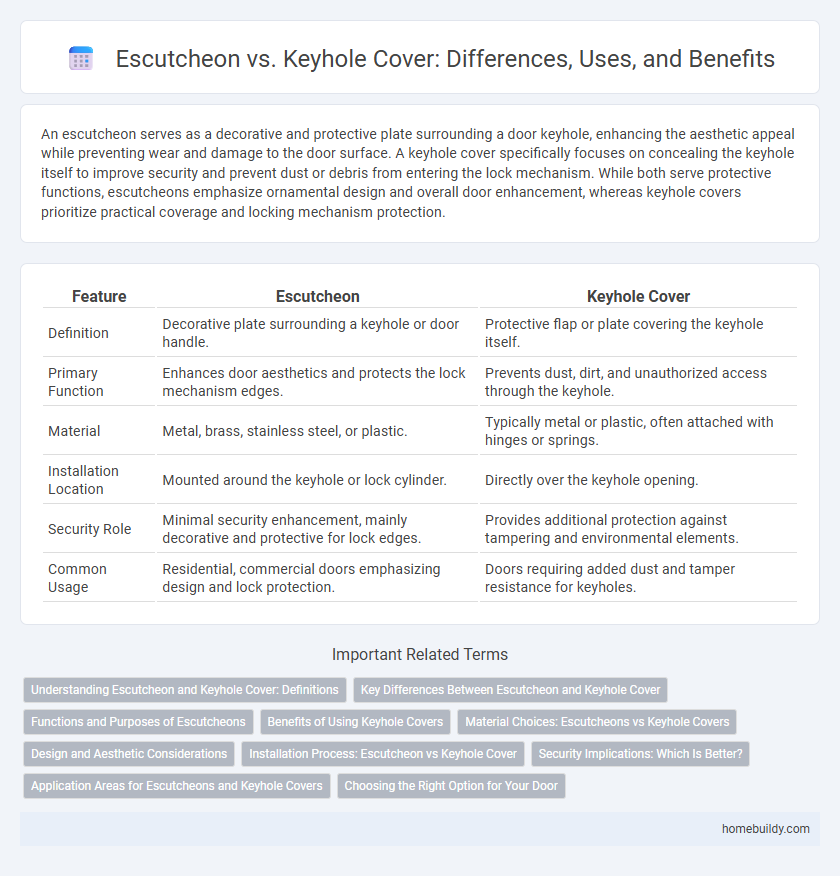An escutcheon serves as a decorative and protective plate surrounding a door keyhole, enhancing the aesthetic appeal while preventing wear and damage to the door surface. A keyhole cover specifically focuses on concealing the keyhole itself to improve security and prevent dust or debris from entering the lock mechanism. While both serve protective functions, escutcheons emphasize ornamental design and overall door enhancement, whereas keyhole covers prioritize practical coverage and locking mechanism protection.
Table of Comparison
| Feature | Escutcheon | Keyhole Cover |
|---|---|---|
| Definition | Decorative plate surrounding a keyhole or door handle. | Protective flap or plate covering the keyhole itself. |
| Primary Function | Enhances door aesthetics and protects the lock mechanism edges. | Prevents dust, dirt, and unauthorized access through the keyhole. |
| Material | Metal, brass, stainless steel, or plastic. | Typically metal or plastic, often attached with hinges or springs. |
| Installation Location | Mounted around the keyhole or lock cylinder. | Directly over the keyhole opening. |
| Security Role | Minimal security enhancement, mainly decorative and protective for lock edges. | Provides additional protection against tampering and environmental elements. |
| Common Usage | Residential, commercial doors emphasizing design and lock protection. | Doors requiring added dust and tamper resistance for keyholes. |
Understanding Escutcheon and Keyhole Cover: Definitions
An escutcheon is a protective or decorative plate surrounding a keyhole, door handle, or lock, enhancing both security and aesthetics by concealing the lock mechanism. A keyhole cover specifically refers to a small flap or plate designed to cover the keyhole itself, preventing dust, dirt, and unauthorized access. While both serve protective functions, escutcheons typically offer broader coverage and design integration compared to the more functional and focused keyhole covers.
Key Differences Between Escutcheon and Keyhole Cover
Escutcheons serve as decorative and protective plates surrounding door locks and handles, providing both aesthetic appeal and safeguarding the locking mechanism from dust and damage. Keyhole covers specifically shield the keyhole itself, preventing dirt and debris from entering and enhancing privacy, often featuring a hinged or sliding mechanism. The primary difference lies in function and scope: escutcheons cover a broader area around the lock, while keyhole covers focus solely on protecting the keyhole aperture.
Functions and Purposes of Escutcheons
Escutcheons serve as protective plates surrounding keyholes or lock cylinders, preventing damage to doors and enhancing security by concealing keyholes from tampering or environmental wear. Unlike keyhole covers, which primarily act as sliding flaps to block the keyhole directly, escutcheons provide a sturdy decorative and functional barrier that supports lock hardware integrity. Their design improves door aesthetics while safeguarding key mechanisms from dirt, moisture, and potential forced entry.
Benefits of Using Keyhole Covers
Keyhole covers provide enhanced protection against dust, dirt, and moisture entering the lock cylinder, thereby prolonging the lifespan of the locking mechanism. They improve security by preventing tampering and unauthorized access to the keyhole, reducing the risk of lock picking. Aesthetic appeal is another benefit, as keyhole covers offer a cleaner, more polished look compared to traditional escutcheons, complementing door designs seamlessly.
Material Choices: Escutcheons vs Keyhole Covers
Escutcheons are commonly crafted from durable metals such as brass, stainless steel, and bronze, ensuring long-lasting protection and aesthetic appeal around door handles and keyholes. In contrast, keyhole covers often utilize lighter materials like plastic or thin metal sheets for easy installation and flexibility in design. The material choice for escutcheons emphasizes robustness and decorative detail, while keyhole covers prioritize functionality and cost-effectiveness.
Design and Aesthetic Considerations
An escutcheon typically offers a larger, more decorative plate that enhances door hardware aesthetics, often featuring intricate designs and finishes tailored to complement interior styles. In contrast, a keyhole cover is usually smaller and simpler, primarily focusing on functionality by concealing the keyhole to protect against dust and improve security. Selecting between an escutcheon and a keyhole cover depends on the desired balance between ornate visual appeal and minimalistic practicality in door design.
Installation Process: Escutcheon vs Keyhole Cover
The installation process for an escutcheon typically involves aligning the plate over the lock or door hardware and securing it with screws, ensuring a precise fit for both aesthetic appeal and protection. In contrast, a keyhole cover requires more detailed positioning to cover the keyhole precisely, often incorporating hinges or sliding mechanisms that demand careful adjustment. Both components need accurate measurement and alignment, but the escutcheon installation is generally quicker and more straightforward compared to the keyhole cover's intricate fitting requirements.
Security Implications: Which Is Better?
Escutcheons provide enhanced security by reinforcing the area around the keyhole, making forced entry more difficult, while keyhole covers mainly serve to conceal the keyhole from dust and tampering. High-security escutcheons often feature hardened materials and anti-drill plates that resist impact and lock-picking attempts. For optimal protection against break-ins, escutcheons are generally considered superior to traditional keyhole covers due to their robust security features and design.
Application Areas for Escutcheons and Keyhole Covers
Escutcheons primarily serve as decorative and protective plates surrounding door locks, keyholes, or handles, commonly used in residential and commercial interior doors to enhance aesthetics and prevent wear. Keyhole covers, on the other hand, are specialized for safeguarding keyholes against dust, dirt, and unauthorized access, often applied in antique furniture, cabinets, and exterior doors where security and preservation are paramount. Both escutcheons and keyhole covers find application in architectural hardware, with escutcheons favoring ornamental and functional door embellishment and keyhole covers prioritizing keyhole protection and security.
Choosing the Right Option for Your Door
Choosing the right option between an escutcheon and a keyhole cover depends on the level of protection and aesthetic appeal desired for your door. Escutcheons provide a sturdy, decorative plate that safeguards the keyhole from damage and dirt while enhancing the door's hardware design. Keyhole covers offer a simpler solution, primarily focusing on concealing the keyhole and preventing dust entry without the additional structural reinforcement.
Escutcheon vs Keyhole Cover Infographic

 homebuildy.com
homebuildy.com